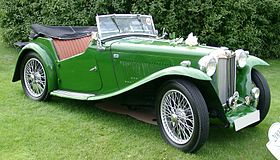MG TC
| MG T-type | |
|---|---|

MG TA Midget
|
|
| Overview | |
| Manufacturer | MG (Morris, later BMC) |
| Production | 1936–1955 |
| Assembly | Abingdon, Oxfordshire, England |
| Body and chassis | |
| Class | Sports car |
| Layout | FR layout |
| Powertrain | |
| Transmission | 4-speed manual |
| Dimensions | |
| Wheelbase | 94 in (2,388 mm) |
| Chronology | |
| Predecessor | MG PB |
| Successor | MGA |
| MG TA Midget | |
|---|---|
 |
|
| Overview | |
| Production | 1936–1939 |
| Body and chassis | |
| Body style | 2-door roadster 2-door Airline coupé 2-door Tickford drophead coupé. |
| Powertrain | |
| Engine | 1,292 cc (1.3 L) MPJG type I4 |
| Dimensions | |
| Length | 140 in (3,556 mm) |
| Width | 56 in (1,422 mm) |
| MG TB Midget | |
|---|---|
 |
|
| Overview | |
| Production | 1939–1940 |
| Body and chassis | |
| Body style | 2-door roadster Tickford drophead coupé |
| Powertrain | |
| Engine | 1,250 cc (1.3 L) XPAG type I4 |
| Dimensions | |
| Length | 140 in (3,556 mm) |
| Width | 56 in (1,422 mm) |
| MG TC Midget | |
|---|---|
 |
|
| Overview | |
| Production | 1945–1950 |
| Body and chassis | |
| Body style | 2-door roadster |
| Powertrain | |
| Engine | 1,250 cc (1.3 L) XPAG type I4 ohv |
| Dimensions | |
| Length | 140 in (3,556 mm) |
| Width | 56 in (1,422 mm) |
| Height | 53 in (1,300 mm) |
| MG TD Midget | |
|---|---|
 |
|
| Overview | |
| Production | 1950–1953 |
| Body and chassis | |
| Body style | 2-door roadster |
| Powertrain | |
| Engine | 1,250 cc (1.3 L) XPAG type I4 |
| Dimensions | |
| Wheelbase | 94 in (2,388 mm) |
| Length | 145 in (3,683 mm) |
| Width | 59 in (1,499 mm) |
| Height | 53 in (1,346 mm) |
| MG TF Midget | |
|---|---|

TF 1250 1953
|
|
| Overview | |
| Production | 1953–1955 |
| Body and chassis | |
| Body style | 2-door roadster |
| Powertrain | |
| Engine | 1,250 cc (1.3 L) XPAG type I4 1,466 cc (1.5 L) XPEG type I4 |
| Dimensions | |
| Length | 147 in (3,734 mm) |
| Width | 59 in (1,499 mm) |
| Height | 52.5 in (1,334 mm) |
The MG T series is a range of body-on-frame convertible sports cars that were produced by MG from 1936 to 1955. The series included the MG TA, MG TB, MG TC, MG TD, and MG TF Midget models. The last of these models, the TF, was replaced by the MGA.
The TF name was reinstated in 2002 on the mid-engined MG TF sports car.
The MG TA Midget replaced the PB in 1936. It was an evolution of the previous car and was 3 inches (76 mm) wider in its track at 45 inches (1,100 mm) and 7 inches (180 mm) longer in its wheelbase at 94 inches (2,400 mm).
The previous advanced overhead-cam inline-four engine was now not in use by any other production car so it was replaced by the MPJG OHV unit from the Wolseley 10 but with twin SU carburettors, modified camshaft and manifolding. The engine displaced just 1292 cc, with a stroke of 102 mm (4.0 in) and a bore of 63.5 mm (2.5 in) and power output was 50 hp (40.3 kW) at 4,500 rpm. The four-speed manual gearbox now had synchromesh on the two top ratios and was connected to the engine by a cork-faced clutch running in oil. Unlike the PB, hydraulic brakes were fitted with 9-inch (230 mm) drums.
Like the PB, most were two-seat open cars with a steel body on an ash frame. A bench-type seat was fitted with storage space behind. From 1938 the car could also be had with a more luxurious Tickford drophead coupé body by Salmons of Newport Pagnell and 252 were made. The soft top could be used in three positions, fully open, closed or open just over the seats. Wind-up windows were fitted to the higher topped doors making the car more weathertight and individual bucket seats used in the fully carpeted interior. Complete chassis were fitted with a very basic body at the Abingdon factory and driven to Newport Pagnell to have their coachwork fitted. A closed Airline coupé made by Carbodies, as fitted to the P type, was also offered but only one or two is thought to have been made.
...
Wikipedia
